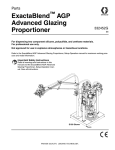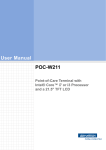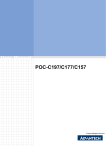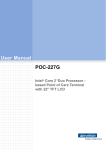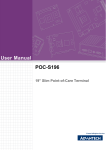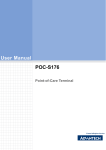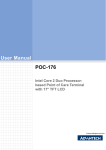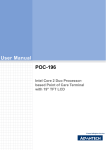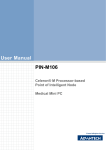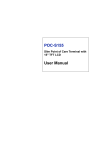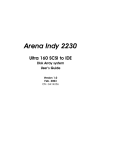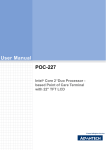Download Advantech POC-S157 User Manual
Transcript
User Manual POC-S197/S177/S157 Copyright The documentation and the software included with this product are copyrighted 2010 by Advantech Co., Ltd. All rights are reserved. Advantech Co., Ltd. reserves the right to make improvements in the products described in this manual at any time without notice. No part of this manual may be reproduced, copied, translated or transmitted in any form or by any means without the prior written permission of Advantech Co., Ltd. Information provided in this manual is intended to be accurate and reliable. However, Advantech Co., Ltd. assumes no responsibility for its use, nor for any infringements of the rights of third parties, which may result from its use. Acknowledgements Intel and Pentium are trademarks of Intel Corporation. Microsoft Windows and MS-DOS are registered trademarks of Microsoft Corp. All other product names or trademarks are properties of their respective owners. Part No. 2008S19700 Edition 1 Printed in Taiwan October 2010 POC-S197/S177/S157 User Manual ii Declaration of Conformity FCC Class B Note: This equipment has been tested and found to comply with the limits for a Class B digital device, pursuant to part 15 of the FCC Rules. These limits are designed to provide reasonable protection against harmful interference in a residential installation. This equipment generates, uses and can radiate radio frequency energy and, if not installed and used in accordance with the instructions, may cause harmful interference to radio communications. However, there is no guarantee that interference will not occur in a particular installation. If this equipment does cause harmful interference to radio or television reception, which can be determined by turning the equipment off and on, the user is encouraged to try to correct the interference by one or more of the following measures: ! Reorient or relocate the receiving antenna. ! Increase the separation between the equipment and receiver. ! Connect the equipment into an outlet on a circuit different from that to which the receiver is connected. ! Consult the dealer or an experienced radio/TV technician for help. Technical Support and Assistance 1. 2. Visit the Advantech web site at http://support.advantech.com where you can find the latest information about the product. Contact your distributor, sales representative, or Advantech's customer service center for technical support if you need additional assistance. Please have the following information ready before you call: – Product name and serial number – Description of your peripheral attachments – Description of your software (operating system, version, application software, etc.) – A complete description of the problem – The exact wording of any error messages – This equipment is a source of electromagnetic waves. Before use please, make sure that there are not EMI sensitive devices in its surrounding which may cause malfunction. Manufacturer Advantech Co., Ltd. No.1, Alley 20, Lane 26, Rueiguang Road Neihu District, Taipei, Taiwan 114, R.O.C. TEL: (02)27927818 Distributed in Europe by: Advantech Europe GmbH Kolberger Straße 7 D-40599 DÜsseldorf, Germany Tel: 49-211-97477350 Fax: 49-211-97477300 Visit the Advantech websites at www.advantech.com or www.advantech.com.tw if you need more information. iii POC-S197/S177/S157 User Manual Instructions for the User The document combines text and illustrations, providing a comprehensive overview of the system. The information is presented as sequential steps of action, allowing the user to learn directly how to use the device. The text provides explanations and instructs the user step by step in the practical use of the product, with short, clear instructions in easy-to-follow sequence. Warnings, Cautions and Notes Warning! Warnings indicate conditions, which if not observed, can cause personal injury! Caution! Cautions are included to help you avoid damaging hardware or losing data. e.g. Note! Notes provide optional additional information. POC-S197/S177/S157 User Manual iv Packing List Before setting up the system, check that the items listed below are included and in good condition. If any item does not accord with the table, please contact your dealer immediately. ! POC-S197/ S177/ S157 series Point of Care Terminal ! CD-ROM disc-"Drivers, User's manual and Utilities" ! Mounting kits and packet of screws ! External DC adapter (Manufacturer: SINPRO Model no.: HPU100-107) Warning! No user serviceable parts inside, refer servicing to qualified personnel. Only the accessories indicated on the list of accessories above have been tested and approved to be used with the device. Accordingly it is strongly recommended that only these accessories be used in conjunction with the specific device. Otherwise the correct functioning of the device may be compromised. Safety Instructions 1. 2. 3. Strictly follow these Instructions for Use, please read these safety instructions carefully. Remember to keep this User's Manual for later reference, and any use of the product requires full understanding and strict observation of all portions of these instructions. Observe all WARNINGS and CAUTIONS as rendered throughout this manual and on labels on the equipment. Repair of the device may also only be carried out by trained service personnel. Advantech recommends that a service contract be obtained with Advantech Service and that all repairs also be carried out by them. Otherwise the correct functioning of the device may be compromised. Warning! Because of the danger of electric shock, never remove the cover of a device while it is in operation or connected to a power outlet. 4. If one of the following situations arises, get the equipment checked by service personnel: ! The power cord or plug is damaged. ! Liquid has penetrated into the equipment. ! The equipment has been exposed to moisture. ! The equipment does not work well, or you cannot get it to work according to the user's manual. ! The equipment has been dropped and damaged. ! The equipment has obvious signs of breakage. v POC-S197/S177/S157 User Manual 5. Disconnect this equipment from any AC outlet before cleaning. Use a damp cloth. Do not use liquid or spray detergents for cleaning and keep this equipment away from humidity. Caution! To avoid short-circuiting and otherwise damaging the device, do not allow fluids to come in contact with the device. If fluids are accidentally spilled on the equipment, remove the affected unit from service as soon as possible and contact the service personnel to verify that patient safety is not compromised. 6. Put this equipment on a reliable surface during installation. Dropping it or letting it fall may cause damage. For plug-in equipment, the power outlet socket must be located near the equipment and must be easily accessible. Caution! To prevent overheating, do not cover the openings and place the device in direct sunlight or near radiant heaters. 7. Make sure the voltage of the power source is correct before connecting the equipment to the power outlet. Position the power cord so that people cannot step on it. Do not place anything over the power cord. If the equipment is not used for a long time, disconnect it from the power source to avoid damage by transient over voltage. Caution! Do not leave this equipment in an uncontrolled environment where the storage temperature is below -20° C (-4° F) or above 60° C (140° F). this may damage the equipment. 8. If your computer clock does not keep the correct time or the BIOS configuration resets to default, the battery has no power. Caution! Do not replace battery yourself. Please contact a qualified technician or your retail. The computer is provided with a battery-powered real-time clock circuit. There is a danger of explosion if battery is incorrectly replaced. Replace only with same or equivalent type recommended by the manufacture. Discard used batteries according to the manufacturerís instructions Caution! The battery charging indicator is not included in this device. It shall be added to the end system assembly and be shown there. 9. Improper installation of VESA mounting can result in serious personal injury! VESA mount installation should be done by a professional technician; please contact the service technician or your retailer if you need this service. Detailed procedures are specified in Appendix C. 10. CLASSIFICATION: 1). Supply Class I adapter 2). No applied part 3). IPX1 POC-S197/S177/S157 User Manual vi 4). Continuous Operation 5). Not AP or APG category Warning! This device is not suitable for use in the presence of a flammable anesthetic mixture with air, oxygen, nitrous oxide, or for life support systems. 11. Environmental protection: follow national requirements to dispose of unit. 12. Maintenance: to properly maintain and clean the surfaces, use only the approved products or clean with a dry applicator. Caution! When servicing the device, always use replacement parts that are qualified to Advantech standards. Advantech cannot warrant or endorse the safe performance of third-party replacement parts for use with our medical devices. 13. Make sure the user does not contact SIP/SOPs and the patient at the same time. 14. When networking with electrical devices, the operator is responsible for ensuring that the resulting system meets the requirements set forth by the following standards: – EN 60601-1 (IEC 60601-1) Medical electrical equipment Part 1: General requirements for safety – EN 60601-1-1 (IEC 60601-1-1) Medical electrical equipment Part 1-1: General requirements for safety Collateral standard: Safety requirements for Medical electrical systems – EN 60601-1-2 (IEC 60601-1-2) Medical electrical equipment Part 1-2: General requirements for safety Collateral standard: Electromagnetic compatibility; Requirements and tests 15. Accessory equipment connected to analog and digital interfaces must be in compliance with the respective nationally harmonized IEC standards (i.e. IEC 60950 for data processing equipment, IEC 60065 for video equipment, IEC 61010-1 for laboratory equipment, and IEC 60601-1 for medical equipment.) Furthermore all configurations shall comply with the system standard IEC 60601-1-1. Anyone who connects additional equipment to the signal input part or signal output part is configuring a medical system, and is therefore, responsible that the system complies with the requirements of the system standard IEC 60601-1-1. The unit is for exclusive interconnection with IEC 60601-1 certified equipment in the patient environment and IEC 60XXX certified equipment outside of the patient environment. If in doubt, consult the technical services department or your local representative. vii POC-S197/S177/S157 User Manual POC-S197/S177/S157 User Manual viii Contents Chapter 1 General Information ............................1 1.1 1.2 1.5 Introduction ............................................................................................... 2 Specifications ............................................................................................ 2 Table 1.1: Touchscreen Specifications........................................ 4 LCD Specifications.................................................................................... 4 Dimensions ............................................................................................... 5 Figure 1.1 Dimensions of the POC-S197 .................................... 5 Figure 1.2 Dimensions of the POC-S177 .................................... 5 Figure 1.3 Dimensions of the POC-S157 .................................... 6 Figure 1.4 POC-S197 front panel ................................................ 6 Figure 1.5 POC-S177/S157 front panel....................................... 7 Figure 1.6 POC-S197/S177/S157 back I/O ................................. 7 Point-of-Care Terminal Cleaning and Disinfecting .................................... 8 2 System Setup .......................................9 2.1 A Quick Tour of the POC-S1x7 ............................................................... 10 Figure 2.1 Front view of the POC-S177/S157 ........................... 10 Figure 2.2 Front view of the POC-S197..................................... 10 Figure 2.3 Rear view of the point of care terminal ..................... 11 Installation Procedures............................................................................ 11 2.2.1 Connecting the Power Cord........................................................ 11 Figure 2.4 Connecting the power cord....................................... 12 2.2.2 Connecting the Ground pin ......................................................... 12 Figure 2.5 Equipotential terminal pin ......................................... 12 Figure 2.6 Grounding cable with connector ............................... 13 Running the BIOS Setup Program .......................................................... 13 Installing System Software...................................................................... 13 Installing the Drivers................................................................................ 14 Figure 2.7 The file directory on "Drivers and Utilities" CD-ROM 14 1.3 1.4 Chapter 2.2 2.3 2.4 2.5 Chapter 3 Chipset and Graphics Setup ............15 3.1 Introduction ............................................................................................. 16 3.1.1 Chipset........................................................................................ 16 3.1.2 Display Memory .......................................................................... 16 3.1.3 DVI-I............................................................................................ 16 3.1.4 Display Types ............................................................................. 16 Installation of Chipset Driver ................................................................... 16 3.2.1 Installation for Windows XP ........................................................ 17 3.2 Chapter Chapter 4 Audio Interface ..................................23 4.1 4.2 4.3 4.4 Introduction ............................................................................................. 24 Installation of Audio Driver ...................................................................... 24 Installation for Windows 2000/XP ........................................................... 25 Further Information.................................................................................. 26 5 PCI Express Ethernet Interface ........27 5.1 Introduction ............................................................................................. 28 ix POC-S197/S177/S157 User Manual 5.2 5.3 Installation of Ethernet Driver.................................................................. 28 5.2.1 Installation for Windows XP ........................................................ 28 Further Information ................................................................................. 30 6 Touch Panel Interface....................... 31 6.1 6.2 6.3 Introduction ............................................................................................. 32 Installation of Touch Panel Driver ........................................................... 32 6.2.1 Installation for Windows XP ........................................................ 32 Further information.................................................................................. 36 7 Utilities and Hot Fixes ...................... 37 7.1 7.2 7.3 Introduction ............................................................................................. 38 Wakeup by External USB Device at S3 Resume (Wakeup) ................... 38 7.2.1 Installation for Windows XP ........................................................ 38 Windows Audio Volume Application ....................................................... 38 Appendix A Windows Display Hot Key Function 39 A.1 Windows Display Hot Key Function ........................................................ 40 Appendix B Description of Connectors............... 41 B.1 Description of Connectors....................................................................... 42 Figure B.1 Top side global view of POC-S1x7 motherboard indicates connector locations........................................ 42 Figure B.2 Bottom side global view of POC-S1X7 motherboard indicates connector locations ..................................... 43 Figure B.3 Top side global view of POC-S1X7 IO indicates connector locations ........................................................ 44 Figure B.4 Top side global view of POC-S1X7 2nd I/O indicates connector locations .................................................. 44 Appendix C VESA Mounting ................................. 45 C.1 Install VESA Mounting ............................................................................ 46 Chapter Chapter POC-S197/S177/S157 User Manual x Chapter 1 1 General Information 1.1 Introduction The S197/ S177/ S157 is a multimedia Intel® CoreTM2 Duo processor-based mobile computer that is designed to serve as a Point of Care terminal (POC). It is a PCbased system with 19”/17”/15” color TFT LCD display, a single DVI-I Port, dual onboard 10/100/1000 PCI-E Ethernet controllers, a single COM port, quad USB 2.0 ports and a 24-bit stereo audio controller. With a built-in 2.5” HDD drive, the S197/ S177/ S157 is as slim and user-friendly as a notebook computer and operates with low audible noise. For system integrators, this silent, compact, mobile and highly integrated multimedia system lets you easily build a Point of Care terminal into your applications. The low audible noise of S197/ S177/ S157 makes it an ideal and safe point of care solution for patients and hospital practitioners. The high contrast ratio of S197/ S177/ S157 makes it a perfect image terminal for PACS and DICOM applications. The S197/ S177/ S157 is a reliable solution to your application's processing requirements. 1.2 Specifications General ! Dimensions (W x H x D): – POC-S197: 472 x 416 x 111 mm (18.58" x 16.38" x 4.37") – POC-S177: 436.5 x 376.5 x 91.4 mm (17.18" x 14.82" x 3.59") – POC-S157: 418 x 342 x 89.3 mm (16.46" x 13.46" x 3.51") ! Weight: – POC-S197: (w/o battery) 8.1 kg – POC-S177: (w/o battery) 7.1 kg – POC-S157: (w/o battery) 5.4 kg ! Power supply: – DC model: 100 watts max External DC Adapter- (Manufacturer: SINPRO Inc. Model no.: HPU100-107) used within POC-S197/S177/S157 – Input voltage: 100 ~ 240 VAC, 47-63 Hz, 1.25 ~ 0.5 A – Output voltage: +18 VDC, 5.55 A max. ! ! Disk drive housing: Space for one 2.5" SATA HDD Entire system: IPX1 compliant Hardware ! CPU: Intel® Core 2 Duo® processor Ultra-low Voltage SU9300 1.2 GHz ! BIOS: SST 8 Mbit SPI Serial Flash BIOS. ! Chipset: Intel® GS45 Express Chipset with 82801IUX I/O Controller Hub (ICH9M-SFF) ! Front side bus: 800 MHz ! RAM: 204-pin, DDR3, SODIMM slots x 2 (max. 4 GB), Unbuffered Non ECC, capacity maximum to 4 GB ! SATA interface: SATA x 1. Supports one SATA device. ! Serial ports: RS-232 ports x 2; they are both compatible with 16C550 UARTs. COM1 has optical isolation; ! Universal serial bus (USB) port: USB 2.0 ports x 5 (3 external, 2 internal) ! Expansion slot: Mini PCI/33MHz slot x 1, Mini PCI-E(2.5 Gb/s) slot x 1 POC-S197/S177/S157 User Manual 2 ! ! Watchdog timer: Supports super I/O embedding watchdog function. Automatically generates system reset when the system stops due to a program error. CMOS battery (BIOS): 3.0 V @ 195 mA lithium battery Backup battery (Optional): 11.1 V @ 6300 mAh lithium battery – Formosan United Corporation or JOULES MILES CO., LTD./ POC-S1X7 Audio function ! Chipset: Realtek ALC888, compliant with Intel HDA. ! Audio controller: 24-bit codec, full-duplex stereo codec ! Audio interface: Microphone-in, Line-out Ethernet interface ! Chipset: INTEL_82574L PCI express high performance Gigabit Ethernet controller ! Ethernet interface: Gigabit Ethernet ports x 2, fully integrated Gigabit Ethernet Media Access Control (MAC) and Physical Layer (PHY) functions, and each provides a standard IEEE 802.3 Ethernet interface for 10/100/1000 Mbps. Optional modules ! Memory: 1GB/2GB, DDR3-800 MHz SODIMM ! HDD: 2.5" SATA HDD ! Mini PCI WLAN module: 802.11a/b/g WLAN ! Mini PCI-E WLAN module: 802.11b/g/n WLAN Environment ! Temperature: 0 ~ 40° C (32 ~ 104° F) (Operating) ! Relative humidity: – -20 ~ 60° C (Storage) – -20 ~ 60° C (Transportation) – Humidity 10 ~ 95%@40° C (non-condensing) – to 95% (non condensing) (Storage) – to 95% (Transportation) – Operating atmospheric pressure: 700 ~ 1060 hPa – Storage atmospheric pressure: 700 ~ 1060 hPa – Transportation atmospheric pressure: 700 ~ 1060 hPa ! Shock: 20 G, half sine, 11 msec duration ! Vibration: 0.047 double amplitude displacement ( 5 ~ 32 Hz), 2 G Peak (32 ~ 500 Hz ) ! Power MTBF: 100,000 hrs ! Altitudes: Operational: 6,000 feet; Shipping : 40,000 feet ! Certifications: – EMC: CE, FCC approved 3 POC-S197/S177/S157 User Manual General Information Display interface ! SDVO interface: PERICOM PI3VDP411LS Digital Video Level Shifter from AC coupled digital video input to a DVI/HDMI transmitter ! Display resolution: Supports 24-bit digital output (DVI-I port) resolutions up to 1920 x 1200. (WUXGA) ! Display type: Simultaneously supports CRT Chapter 1 ! – Safety: UL60601-1 and EN60601-1 approved. This device bears the CE label in accordance with the provisions of the EMC Directive 89/336/EMC and the Low Voltage Directive 73/23/EEC. Touchscreen (optional) Table 1.1: Touchscreen Specifications Type Analog Resistive Resolution Continuous Light Transmission 75% Controller RS-232 interface (uses COM6) Power Consumption +5 V @ 200 Ma Software Driver Supports Windows 2000,Windows XP Durability (touches in a lifetime) 30 million Note! The Point of Care Terminal with the optionally installed touchscreen will share COM6. Once the touchscreen is installed, COM6 cannot be used for other purposes. Optional modules ! Memory: 1 GB/2 GB, DDR3 800 MHz DRAM ! HDD: 2.5" SATA HDD ! Touchscreen: Analog resistive 1.3 LCD Specifications POC-S197 ! Display type: 19" TFT LCD. ! Resolution: 1280 x 1024 ! Colors: 16.7 M (8 bits/color) ! Dot size (mm): 0.294 x 0.294 ! Viewing angle: 178° x 178° ! ! ! ! Luminance: 300 cd/m2 Contrast ratio: 1300 : 1 LCD MTBF: 50,000 hours Backlight lifetime: 50,000 hours POC-S177 ! Display type: 17" TFT LCD ! Resolution: 1280 x 1024 ! Colors: 16.7 M (8 bits/color) ! Dot size (mm): 0.264 x 0.264 ! Viewing angle: 140° x 130° ! Luminance: 300 cd/m2 ! Contrast ratio: 500 : 1 ! LCD MTBF: 50,000 hours ! Backlight lifetime: 50,000 hours POC-S157 POC-S197/S177/S157 User Manual 4 ! ! ! ! Luminance: 350 cd/m2 Contrast ratio: 400 : 1 LCD MTBF: 50,000 hours Backlight lifetime: 50,000 hours General Information Display type: 15" TFT LCD. Resolution: 1024 x 768 Colors: 262,144 (6 bits/color) Dot size (mm): 0.264 x 0.264 Viewing angle: 120° Chapter 1 ! ! ! ! ! 1.4 Dimensions Figure 1.1 Dimensions of the POC-S197 Figure 1.2 Dimensions of the POC-S177 5 POC-S197/S177/S157 User Manual Figure 1.3 Dimensions of the POC-S157 AB C D E F Figure 1.4 POC-S197 front panel A. Power Switch B. Touchscreen Light Indicator C. Touchscreen Status Control D. Volume Up/Down E. Brightness Increase/Decrease F. Read Light Control POC-S197/S177/S157 User Manual 6 Chapter 1 B C Figure 1.5 POC-S177/S157 front panel A. Audio Control Button B. Power Light C. Brightness Control Button A B C D E F G Figure 1.6 POC-S197/S177/S157 back I/O A. 4-pin mini-DIN DC connector B. USB 2.0 ports x 3 C. DVI-I port D. Isolated 10/100/1000 Mbps Ethernet interface x 2 (RJ-45) E. Isolated RS-232 COM 2 port F. Isolated RS-232/422/485 COM 1 port (by jumper selection) 7 POC-S197/S177/S157 User Manual General Information A G. Power switch 1.5 Point-of-Care Terminal Cleaning and Disinfecting During normal use of the POC (Point-of-Care Terminal) the device may become dirty and should be regularly cleaned. Steps: 1. Prepare cleaning agent per manufacturer’s instructions or hospital protocol. 2. Wipe the POC with a clean cloth that has been moistened in the cleaning solution. 3. Wipe thoroughly with a clean cloth. Cleaning agent list: chemical disinfectants which have been tested on the POC. No Cleaning Agents 1 Cidex 2 Isopropyl alcohol 3 Green tinctured soap 4 Windex 5 Alcohol 6 Alcohol 70% 7 Chloride 1000PPM 8 Incidin plus 9 Incidin liquid 10 Mikrozid liquid Caution! ! ! ! Do not immerse or rinse the POC or its peripherals. If you accidentally spill liquid on the device, disconnect the unit from the power source. Contact your Biomed Department regarding the continued safety of the unit before placing it back in operation. Do not spray cleaning agents on the chassis. Do not use disinfectants that contain phenol. Do not autoclave or clean the POC or its peripherals with strong aromatic, chlorinated, ketone, ether, or Esther solvents, sharp tools or abrasives. Never immerse electrical connectors in water or other liquids. POC-S197/S177/S157 User Manual 8 Chapter 2 System Setup 2 2.1 A Quick Tour of the POC-S1x7 Before you start to set up the POC-S177/S157, take a moment to become familiar with the locations and purposes of the controls, drives, connections and ports, which are illustrated in the figures below. When you place the POC-S177/S157 upright on the desktop, its front panel appears as shown in Figure 2.1. Figure 2.1 Front view of the POC-S177/S157 When you place the POC-S197 upright on the desktop, its front panel appears as shown in Figure 2.2. Figure 2.2 Front view of the POC-S197 When you turn the Point-of-Care terminal around and look at its rear cover, the sunken white dot section is at the bottom of the panel PC, as shown in Figure 2.3. (The I/O section includes white dot ports, including serial ports, DVI port, the Ethernet port, USB ports, the DC power adapter jack, and so on.) POC-S197/S177/S157 User Manual 10 Chapter 2 System Setup Figure 2.3 Rear view of the point of care terminal 2.2 Installation Procedures 2.2.1 Connecting the Power Cord The POC-S177 can only be powered by a DC power adapter (SINPRO Model no.HPU100-107). Be sure to always handle the power cords by holding the plug ends only. Follow these procedures in order: 1. Connect the female end of the power adapter to the DC jack of the panel PC. (See Figure 2.3.) 2. Connect the female end of the power cord to the DC power adapter 3. Connect the 3-pin male plug of the power cord to an electrical outlet. Warning! POC-S197/S177/S157 is supplied by a 100 watt power supply and a special adapter. If a medical adaptor is connected to the POC-S177, the customer must ensure legal and regulatory compliance that the device meets the law and standards compliance requirements of this hardware. Switching on the power Switch on the power switch on the back I/O for POC-S177/S157 (The color indicator is green). Push down the power button on the front panel for POC-S197 (The color indicator is green). 11 POC-S197/S177/S157 User Manual Figure 2.4 Connecting the power cord 2.2.2 Connecting the Ground pin 1. Ready the system and find the equipotential terminal on rear side of POC An equipotential terminal is provided to optionally connect to a hospital ground/ earth system). POC-S157/S177 POC-S197 Figure 2.5 Equipotential terminal pin POC-S197/S177/S157 User Manual 12 Prepare the grounding cable and the other terminal link to hospital ground/earth system. 3. Grounding cable plug with equipotential terminal 2.3 Running the BIOS Setup Program Your POC-S197/S177/S157 is likely to have been properly set up and configured by your dealer prior to delivery. You may still find it necessary to use the BIOS (Basic Input-Output System) setup program to change system configuration information, such as the current date and time or your type of hard drive. The setup program is stored in read-only memory. It can be accessed either when you turn on or reset the panel PC, by pressing the "Crtl+Alt+Del" key on your keyboard immediately after powering on the computer. The settings you specify with the setup program are recorded in a special area of memory called CMOS RAM. This memory is backed up by a battery so that it will not be erased when you turn off or reset the system. Whenever you turn on the power, the system reads the settings stored in CMOS RAM and compares them to the equipment check conducted during the power on self-test (POST). If an error occurs, an error message will be displayed on screen, and you will be prompted to run the setup program. 2.4 Installing System Software Recent releases of operating systems from major vendors include setup programs which load automatically and guide you through hard disk preparation and operating system installation. The guidelines below will help you determine the steps necessary to install your operating system on the panel PC hard drive. Note! Some distributors and system integrators may have already preinstalled system software prior to shipment of your panel PC. If required, insert your operating system's installation or setup diskette into the external diskette drive until the release button pops out. The BIOS supports system boot-up directly from the CD-ROM drive. You may also insert your system installation CD-ROM disk into your external CD-ROM drive. Power on or reset the system by pressing the "Ctrl"+"Alt"+"Del" keys simultaneously. The Point of Care Terminal will automatically load the operating system from the diskette or CD-ROM. 13 POC-S197/S177/S157 User Manual System Setup Figure 2.6 Grounding cable with connector Chapter 2 2. If you are presented with the opening screen of a setup or installation program, follow the instructions on screen. The setup program will guide you through preparation of your hard drive, and installation of the operating system. 2.5 Installing the Drivers After installing your system software, you will be able to set up the Chipset, Graphics, Ethernet, Audio, Touchscreen and Bluetooth functions from your own external CDROM drive. All the drivers except the CD-ROM drive driver are stored in a CD-ROM disc entitled "Drivers and Utilities." The standard procedures for installing the Chipset, Graphics, Audio and Ethernet drivers are described in Chapters 3, 4, 5, and 6 respectively. The various drivers and utilities in the CD-ROM disc have their own text files which help users install the drivers and understand their functions. These files are a very useful supplement to the information in this manual. For your reference, the directory of drivers on the "Drivers and Utilities" CD-ROM is: Figure 2.7 The file directory on "Drivers and Utilities" CD-ROM Note! The drivers and utilities used for the POC-S197/S177/S157 panel PCs are subject to change without notice. If in doubt, check Advantech's website or contact our application engineers for the latest information regarding drivers and utilities. POC-S197/S177/S157 User Manual 14 Chapter 3 3 Chipset and Graphics Setup 3.1 Introduction The POC-S197/S177/S157 has an onboard display interface. The specifications and features are described as follows: 3.1.1 Chipset The POC-S197/S177/S157 uses a mobile Intel GS45 Express chipset for its graphic controller. It supports HDMI and CRT monitors. The Mobile Intel GS45 Express chipset are designed for use with Intel® CoreTM2 Duo, Intel® CoreTM2 Solo and Intel® Celeron® mobile processors based on the 45-nm process. 3.1.2 Display Memory Intel® Dynamic Video Memory Technology (Intel® DVMT 5.0) 3.1.3 DVI-I The POC-S197/S177/S157 has signal channel DVI-I ports. The device accepts one channel of RGB data over three pairs of serial data ports. The POC-S177 is able to drive a DVI display at a pixel rate of up to 165 MHz, supporting WUXGA (1920 x 1200) resolution display. 3.1.4 Display Types POC-S197/S177/S157 supports a single DVI-I jack for single monitor. The DVI-I jack supports both a DVI Digital I/F and a CRT RGB signal. The analog CRT DAC interface supports a max DAC frequency up to 400 MHz, 24-bit RAMDAC, is DDC2B compliant, and resolutions up to QXGA 2048 x 1536. 3.2 Installation of Chipset Driver Complete the following steps to install the Chipset driver. Follow the procedures in the flow chart that apply to the operating system that you are using within your POCS197/S177/S157. Note! The following Windows illustrations are examples only. You must follow the flow chart instructions and pay attention to the instructions which appear on your screen. Note! The CD-ROM drive is designated as “D” throughout this chapter. Note! <Enter> means pressing the “Enter” key on the keyboard. Note! Before you install the graphics driver of POC-S197/S177/S157, please ensure you have installed the “Intel Chipset Software Installation Utility”. You can find this driver in the Utility CD-ROM. POC-S197/S177/S157 User Manual 16 The resolution of the Window’s display will be 640 x 480 before you install a graphics driver. Depending on your monitor’s native resolution, the black area might be different. 3.2.1 Installation for Windows XP 1. 3. Read the License Agreement and click “Yes” to proceed. 17 POC-S197/S177/S157 User Manual Chipset and Graphics Setup 2. Double click “infinst_autol.exe” in the D:\Driver\XP\chipset folder. The Install dialog will appear. Click “Next” to continue. Chapter 3 Note! 4. Read file information and click “Next” to proceed. 5. Setup Progress information is displayed. Click “Next” to proceed. POC-S197/S177/S157 User Manual 18 1. Double click “winxp_14383.exe” in D:\Driver\XP\Graphic folder. The Install dialog will appear. Click 'Next' to continue. 2. 19 POC-S197/S177/S157 User Manual Chipset and Graphics Setup When the “Setup COMPLETE” message appears click “Finish” to restart your computer. Chapter 3 6. 3. Click “Next” to continue. 4. Read the License Agreement and click “Yes” to proceed. POC-S197/S177/S157 User Manual 20 6. When the “Click Next to continue” message appears click “Next” to proceed. 21 POC-S197/S177/S157 User Manual Chipset and Graphics Setup Readme file information and click “Next” to proceed. Chapter 3 5. 7. When the “Setup Is Complete” message appears click “Finish” to restart your computer. POC-S197/S177/S157 User Manual 22 Chapter 4 Audio Interface 4 4.1 Introduction The POC-S197/S177/S157's onboard audio interface provides high-quality stereo sound by using the ALC888 audio controller from Realtek. The ALC888 series are high performance 7.1+2 channel High Definition Audio Codecs providing ten DAC channels that simultaneously support 7.1 sound playback, plus 2 channels of independent stereo sound output (multiple streaming) through the front panel stereo outputs. All analog jacks are input and output capable, and headphone amplifiers are also integrated at each analog output. All analog I/Os can be re-tasked according to user definitions, or automatically switched depending on the connected device type. 4.2 Installation of Audio Driver Before installing the audio driver, please take note of the procedures detailed below. You must know which operating system you are using on your POC-S197/S177/ S157. Refer to the corresponding installation flow chart. Just follow the steps in the flow chart. You can quickly and successfully complete the installation, even if you are not familiar with instructions for Windows. This setup program will install the audio driver and Realtek utility onto your system. Note! The following Windows illustrations are examples only. You must follow the flow chart instructions and pay attention to the instructions which appear on your screen. Note! The CD-ROM drive is designated as “D” throughout this chapter. Note! <Enter> means pressing the “Enter” key on the keyboard. POC-S197/S177/S157 User Manual 24 1. 2. Double Click “setep.exe” in the D:\Driver\XP\Audio folder. The Install dialog will appear. Click “Next” to continue. The install program will install a driver and utility. It will spend a period of time processing. Chapter 4 4.3 Installation for Windows 2000/XP Audio Interface 3. When the “InstallShield Wizard Complete” message appears click “Finish” to restart your computer. 25 POC-S197/S177/S157 User Manual 4.4 Further Information For further information about the Audio interface installation for your POC-S197/ S177/S157, including driver updates, troubleshooting guides and FAQ lists please visit the following web resources. Realtek website: www.realtek.com.tw Advantech websites: www.advantech.com www.advantech.com.tw POC-S197/S177/S157 User Manual 26 Chapter 5 5 PCI Express Ethernet Interface 5.1 Introduction The POC-S197/S177/S157 is equipped with a high performance PCIe Ethernet chipset Intel® 82574L which is fully compliant with the 1 Gbps IEEE 802.3, 802.3u, 802.3ab specifications. Full duplex operation at 10/100/1000 Mbps standard. The Ethernet port provides a standard RJ-45 jack. 5.2 Installation of Ethernet Driver 5.2.1 Installation for Windows XP 1. 2. Double click “Network Adapter Drivers for Windows XP and Windows Server 2003.exe” in the D:\Driver\XP folder. The Install dialog will appear. Click “Next” to continue. POC-S197/S177/S157 User Manual 28 4. Setup Options file information and click “Next” to proceed. 29 POC-S197/S177/S157 User Manual PCI Express Ethernet Interface Choose the ”I accept the terms in the license agreement” and click “Next” to continue. Chapter 5 3. 5. Click “Install” to begin the installation. 6. When the “InstallShield Wizard Complete” message appears click “Finish”. 5.3 Further Information For further information about the installation on your POC-S197/S177/S157, including driver updates, troubleshooting guides and FAQ lists please visit the following web resources. Intel website: www.intel.com Advantech websites: www.advantech.com www.advantech.com.tw POC-S197/S177/S157 User Manual 30 Chapter 6 6 Touch Panel Interface 6.1 Introduction The POC-S197/S177/S157 is supported by a system integrated touch panel. The touch panel controller is controlled by the system COM interface. 6.2 Installation of Touch Panel Driver 6.2.1 Installation for Windows XP 1. 2. Double Click “setep.exe” in the D:\Driver\XP\Touch folder. The Install dialog will appear. Click ”Next” to continue. POC-S197/S177/S157 User Manual 32 4. Click “Next” to continue. Please select “None” for Do 4-point calibration; the driver install program will do this 4-point calibration when the install completes. 33 POC-S197/S177/S157 User Manual Touch Panel Interface Click “Next” to continue. The POC-S197/S177/S157ís touch controller is controlled by COM6, please do not select the “Install PS/2 interface driver”. Chapter 6 3. 5. Click “Next” to continue. Please select “Support Multi-Monitor System”. 6. Click “Next” to continue. If you want to change the driver destination folder, you can click the “Browse” button to change the folder. POC-S197/S177/S157 User Manual 34 Click “Next” to continue. 8. Click “Yes” to continue. The install program will search the touch screen controller, and find it on COM6. Chapter 6 7. POC-S197/S177/S157 User Manual Touch Panel Interface 35 9. Click “Yes” to continue. Please do 4-point calibration to calibrate the touchscreen. 10. Touch “X” at each of the four corners once on the panel. Please touch each “X” icon displayed in the corner until the icon stops blinking. 6.3 Further information For further information about the installation on your POC-S197/S177/S157, including driver updates, troubleshooting guides and FAQ lists please visit the following web resources. Advantech websites: www.advantech.com www.advantech.com.tw POC-S197/S177/S157 User Manual 36 Chapter 7 7 Utilities and Hot Fixes 7.1 Introduction The POC-S197/S177/S157 system needs specific utilities or hot fixes to support special functions. 7.2 Wakeup by External USB Device at S3 Resume (Wakeup) POC-S197/S177/S157 supports three different sleep (suspend) modes, they are: 1. S1: Power On Suspend; system will stop the clock, turn off LCD backlight, but keep all power on. A user can press any key (by mouse or keyboard) to wakeup system. 2. S3: Suspend to RAM; system will stop the clock, turn off most power rails, not including memory power. All necessary information is saved into memory. In this sleep mode, the system needs a hot fix to wakeup the system by USB mouse or keyboard. 3. S4: Suspend to Disk (Hibernation); system will stop the clock, turn off most power, including the memory power. And save all necessary information to hard disk. In this sleep mode, a user needs to press the power button to wakeup the system. 7.2.1 Installation for Windows XP 1. 2. 3. Double click the “USBRG.REG” in the D:\Driver\USB folder Click “Yes” to install this registry information. Click “OK” to close the “successfully installed” information window. 7.3 Windows Audio Volume Application On the front panel of the POC-S197/S177/S157 system, there are two buttons to control the speaker volume. This speaker volume is adjustable pressing a button and it does not need any software utility. However, this speaker volume button cannot modify Windows volume control. POC-S197/S177/S157 User Manual 38 Appendix A A Windows Display Hot Key Function A.1 Windows Display Hot Key Function If a user wants to switch the display content to different a display device, such as: 1. Internal LCD Panel (Notebook) 2. External CRT Monitor (Monitor) 3. External DVI Monitor (Digital Display) They can press the hot key below to switch the display device. Hot Key Display Device Ctrl+Alt+F1 External CRT Monitor Ctrl+Alt+F3 Internal LCD Panel Ctrl+Alt+F4 External DVI Monitor Windows will switch the display content to dedicated display device soon. POC-S197/S177/S157 User Manual 40 Appendix B Description of Connectors B B.1 Description of Connectors 5 4 9 3 2 8 1 7 6 Figure B.1 Top side global view of POC-S1x7 motherboard indicates connector locations POC-S197/S177/S157 User Manual 42 11 12 16 13 15 14 Figure B.2 Bottom side global view of POC-S1X7 motherboard indicates connector locations No. Description No. Description 1 DDR 2 S.O. DIMM Socket Connector*2 9 LVDS VCC option 2 Internal USB Connector 10 EC Connector 3 SATA Power Connector 11 Touchscreen I/F Connector 4 SATA Connector 12 Touch LED connector 5 LVDS connector 13 Internal Audio Connector (Line, HP Out& Line, MIC In & Speaker Out) 6 BIOS 14 I/O Bus Connector 7 Mini PCI-E Socket 15 Inverter Connector 8 Mini PCI Socket 16 RTC Battery Connector 43 POC-S197/S177/S157 User Manual Appendix B Description of Connectors 10 11 1 13 2 3 12 4 5 6 7 8 9 10 Figure B.3 Top side global view of POC-S1X7 IO indicates connector locations No. Description No. Description 1 Battery Connector 8 RJ-45 Jack (LAN 2) 2 DC-in Power Connector 9 Isolation COM2 Jack 3 USB connector 10 Isolation COM1 Jack (RS232, RS422, RS485) 4 USB connector 11 Power button LED Connector 5 USB connector 12 COM1 RS-232/422/485 Selection Jumper (Default: RS232) 6 DVI Connector 13 USB Header 7 RJ-45 Jack (LAN 1) 10 1 12 2 3 4 11 5 6 7 8 9 Figure B.4 Top side global view of POC-S1X7 2nd I/O indicates connector locations No. Description 1 Battery Connector 7 Isolation COM3 Jack 2 DC-in Power Connector 8 Isolation COM2 Jack 3 USB connector 9 Isolation COM1 Jack (RS-232, RS-422, RS-485) 4 USB connector 10 Power Button LED Connector 5 COM4 Jack (Without isolation) 11 COM1 RS-232/422/485 Selection Jumper (Default: RS232) 6 RJ-45 Jack (LAN 1) 12 USB Header POC-S197/S177/S157 User Manual No. 44 Description Appendix C VESA Mounting C C.1 Install VESA Mounting The Panel PC also provides standard VESA mounting to help system integrators conveniently integrate the panel PC into their system. Never use the mounting brackets except those provided by Advantech to prevent the unreliable fixing of the Panel PC. VESA mount installation should be operated by professional technician, please contact a service technician or your retailer if you need this service. VESA mounting dimensions (75 x 75 mm, 100 x 100 mm) Installation instructions follow: 1. The wall-mounting attachment is comprised of two parts: one back bracket, and one mounting bracket. 2. First attach the back bracket to the rear cover of the Panel PC, securing it in place with four of the philips-head screws provided. 3. Mount the mounting bracket on the wall or other flat surface. The back bracket slides vertically from the top into the mounting bracket. It can be secured to the mounting bracket by screwing four of the philips-head screws provided through the corresponding holes at the tops of the mounting bracket. POC-S197/S177/S157 User Manual 46 Appendix C VESA Mounting 47 POC-S197/S177/S157 User Manual www.advantech.com Please verify specifications before quoting. This guide is intended for reference purposes only. All product specifications are subject to change without notice. No part of this publication may be reproduced in any form or by any means, electronic, photocopying, recording or otherwise, without prior written permission of the publisher. All brand and product names are trademarks or registered trademarks of their respective companies. © Advantech Co., Ltd. 2010


























































